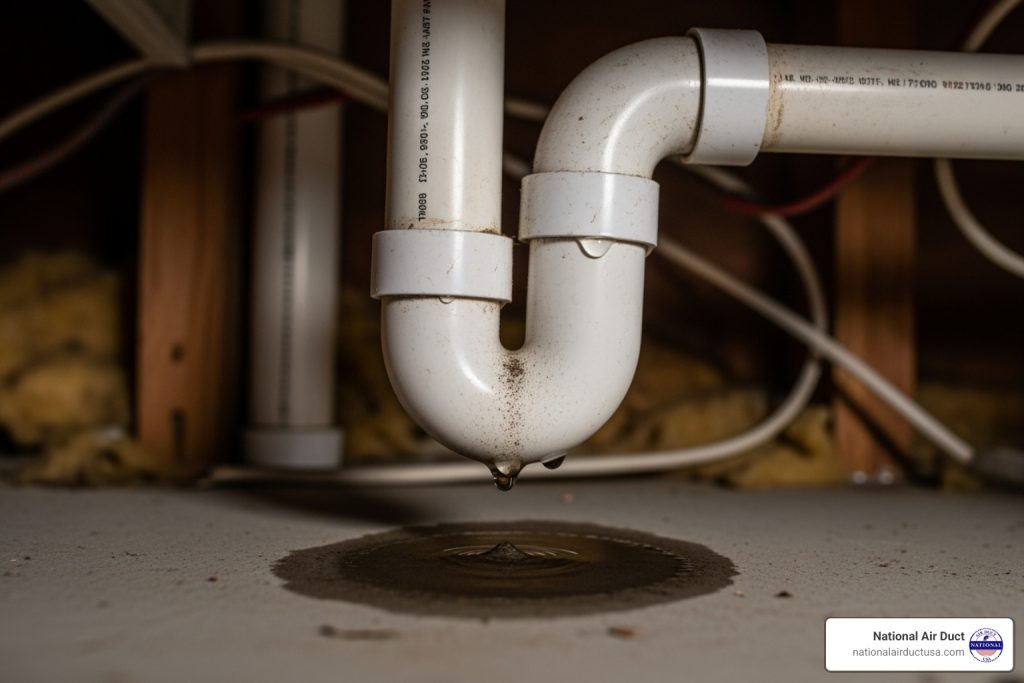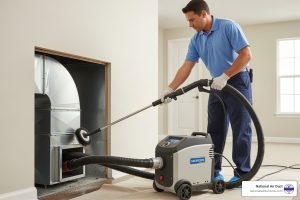Why a Clean AC Drain Line is Crucial for Your Home
Quick Steps:
- Turn off AC power at thermostat and breaker
- Locate the outdoor drain line exit (usually a small PVC pipe)
- Use a wet/dry vacuum to suction out clogs
- Pour 1/4 cup distilled vinegar into the indoor cleanout port
- Let sit 30 minutes, then flush with water
- Turn AC back on and check for proper drainage
Your air conditioner doesn’t just cool your home; it also removes moisture from the air. As warm, humid air passes over the cold evaporator coil, condensation forms and drips into a drain pan. This water then flows through the condensate drain line to exit outside your home.
Over time, this drain line can become clogged with algae, mold, dust, and debris, leading to serious consequences. A clogged drain line can cause your AC to shut down, lead to water damage, and create a breeding ground for mold. Most modern AC systems have float switches that automatically turn off your unit when water backs up, leaving you hot and uncomfortable until the clog is fixed.
Fortunately, cleaning your AC drain line is a task most homeowners can handle in about 30 minutes with basic tools. Regular maintenance can prevent costly repairs and keep your system running efficiently.
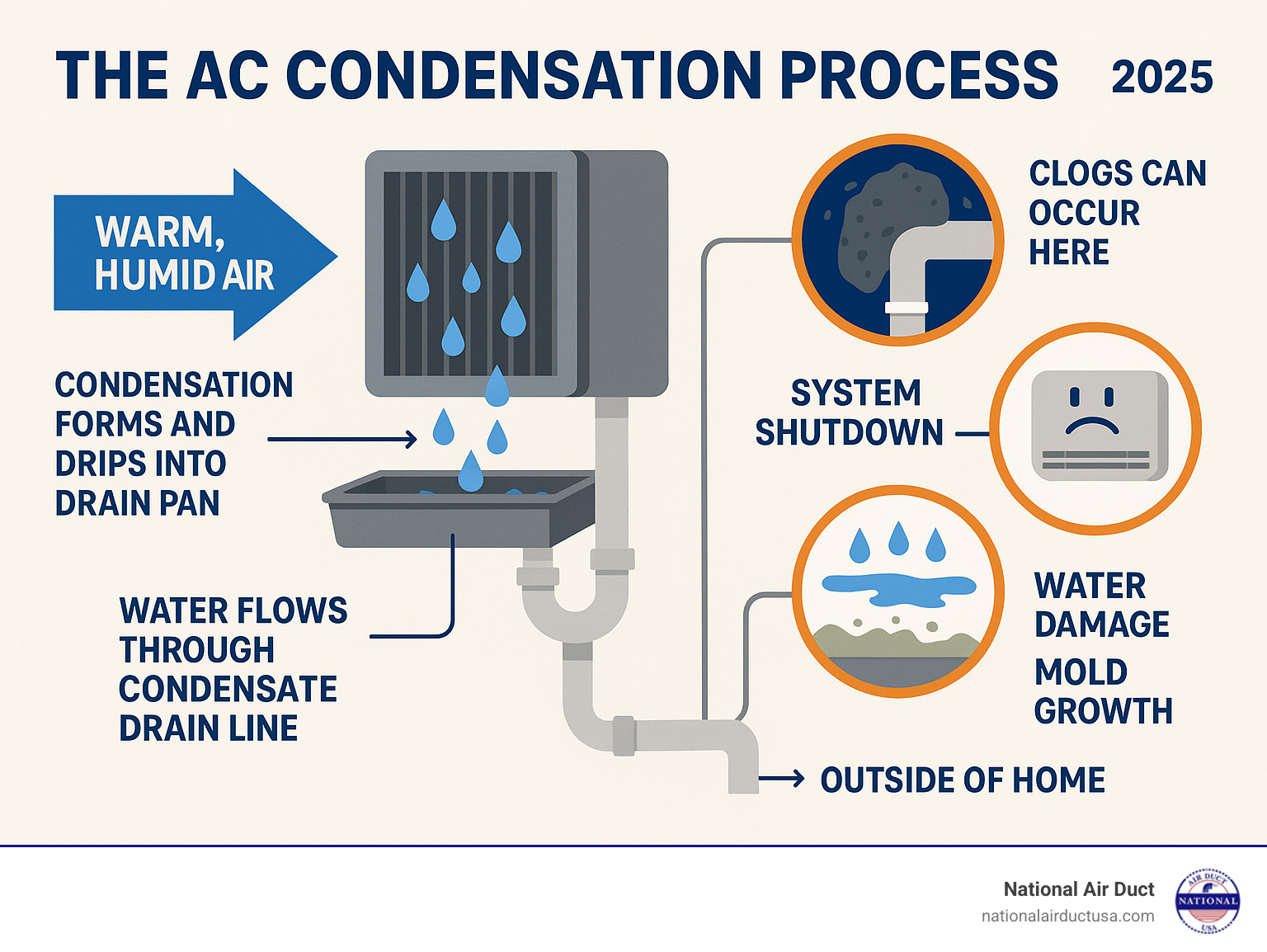
Understanding the Signs and Causes of a Clogged AC Drain Line
When the condensate drain line gets blocked, your AC system will show clear warning signs. Recognizing them early can save you from headaches and costly repairs.
Key Warning Signs to Look For
Knowing what to look for is the first step in diagnosing a clog.
- Standing water in the drain pan: This is the most direct sign of a blockage. The pan is designed to collect condensation, so pooled water means it isn’t draining properly.
- Water stains on ceilings or walls: This indicates the drain pan has overflowed, and water is now escaping where it shouldn’t, leading to costly damage.
- Musty or moldy odors: Stagnant water in the drain line is a perfect breeding ground for mold and algae, which produce a distinct, unpleasant smell.
- AC not cooling effectively: A clogged line can impair the system’s ability to dehumidify, making your home feel less cool even when the AC is running.
- AC system shuts down unexpectedly: Most modern ACs have a float switch that senses high water levels in the drain pan and automatically shuts the system off to prevent an overflow. This may also cause a blank thermostat display.
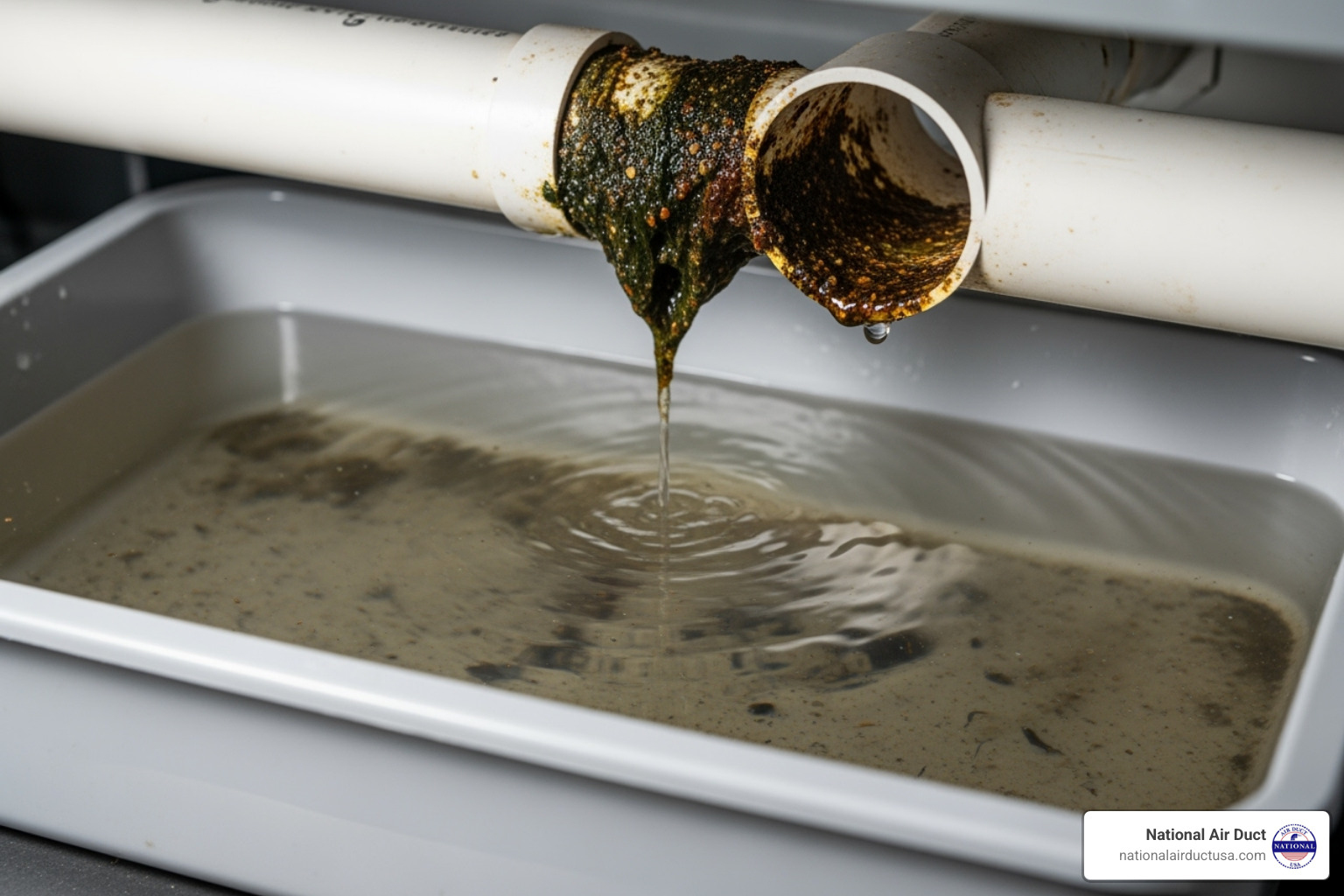
If you notice these signs, it’s time to clean air conditioner drain line.
Common Causes and Consequences of a Clog
The main culprits behind clogs are algae and mold buildup. The cool, dark, and moist conditions inside the drain line are perfect for these organisms to form a slimy sludge that restricts water flow. Additionally, dust and debris from dirty filters can wash into the drain pan and line, contributing to the blockage. Occasionally, insects or pests can build nests in the outdoor exit point.
A clogged drain line is more than an inconvenience. It can lead to reduced AC efficiency and increased indoor humidity, making your system work harder and your home feel muggy. If left unaddressed, a clog can cause severe water damage, widespread mold growth, and even short-circuit electrical components, resulting in the need for expensive HVAC Repair.
How to Clean an Air Conditioner Drain Line: A Step-by-Step Guide
Ready to tackle that clog? Cleaning your air conditioner drain line is a manageable DIY project that can restore your AC’s performance in about 30 minutes.
Essential Tools and Safety Precautions
First, gather your tools. You will need a wet/dry shop vacuum, rags or old towels, a funnel, duct tape, and a stiff wire brush. For your protection, wear protective gloves and safety glasses.
Safety First: Before starting, you must turn off power at both the thermostat and the breaker box. Set the thermostat to “Off,” then find the breakers for your AC and furnace (often labeled “AC,” “Furnace,” or “HVAC”) and switch them off to prevent electrical accidents.
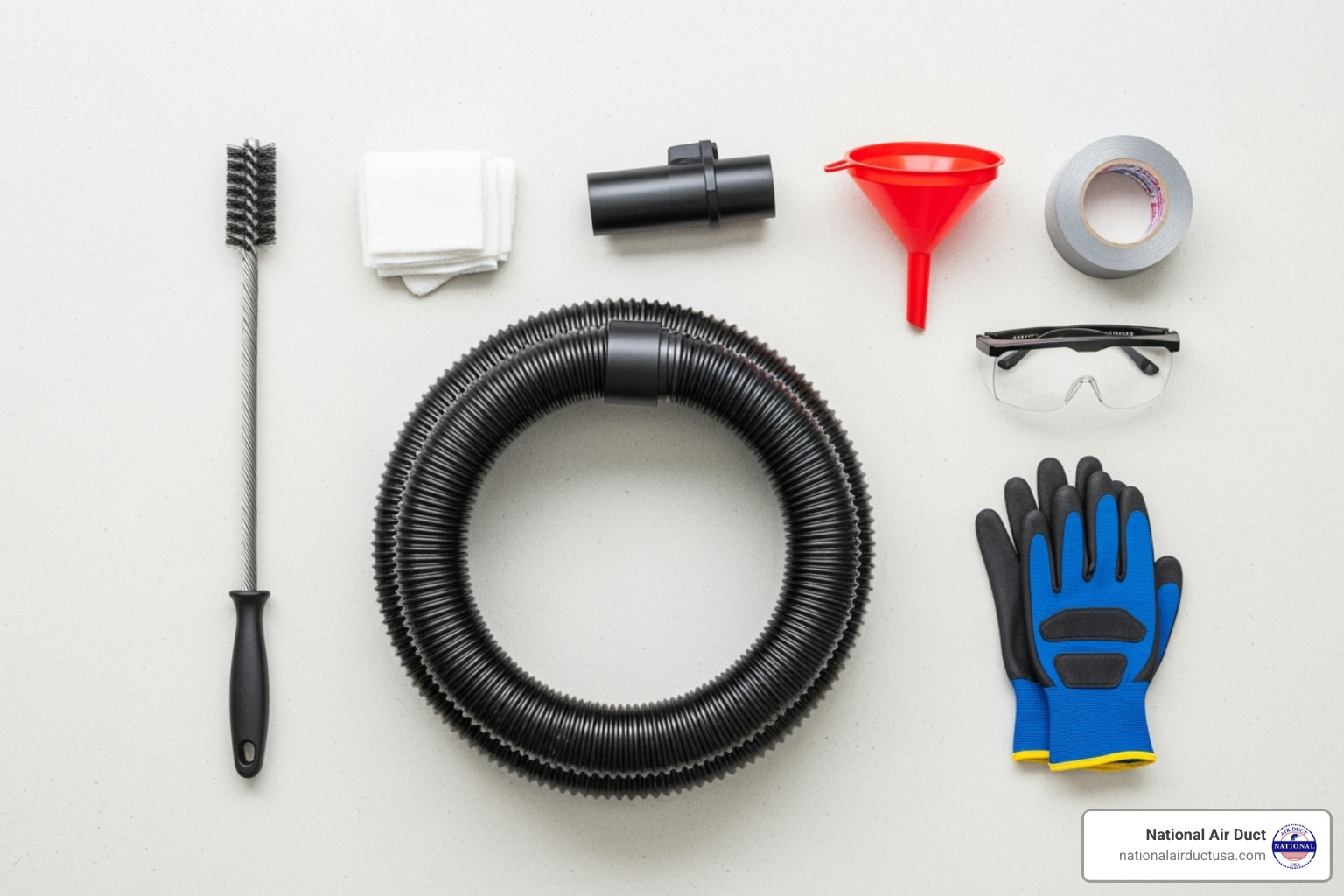
Step-by-Step Instructions to Clean an Air Conditioner Drain Line
With the power off, it’s time to get to work.
- Locate your indoor air handler. It’s typically in an attic, basement, utility closet, or garage.
- Find the condensate drain line. This is a small PVC pipe (usually 3/4-inch) coming from the unit. Look for a T-shaped cleanout port with a removable cap near the air handler.
- Inspect and clear initial blockages. Remove the PVC cap and use a wire brush to gently dislodge any visible gunk. If there’s standing water in the drain pan, remove it with your shop vac or towels.
- Vacuum the outdoor drain exit. Go outside and find where the PVC pipe exits your home. Attach your wet/dry vacuum hose to this opening, using duct tape or your hand to create a tight seal. Run the vacuum for 2-3 minutes to suck out water and debris.
- Flush the line. Pour water into the indoor cleanout port to ensure the line is clear before adding a cleaning solution.
Using Vinegar or Bleach for a Thorough Clean
Now, kill any remaining mold and algae. You can use distilled white vinegar or a diluted bleach solution.
Vinegar is a natural, non-corrosive disinfectant that is safe for your pipes. If you prefer bleach for its stronger disinfecting power, be sure to dilute it: mix 1 part bleach with 6 parts warm water.
Using your funnel, slowly pour your chosen solution into the cleanout port—about 1/2 to 1 cup of vinegar or 1 cup of the diluted bleach mixture. Let the solution sit for 10 to 30 minutes to break down any remaining buildup.
After waiting, flush the line by pouring 1/2 to 1 gallon of warm water down the cleanout port. Have a helper check the outdoor exit to confirm a steady flow of water. Clear flow means success!
Critical Safety Warning: Never mix bleach and vinegar! This combination creates toxic chlorine gas. You can learn more about this danger at this warning about mixing chemicals.
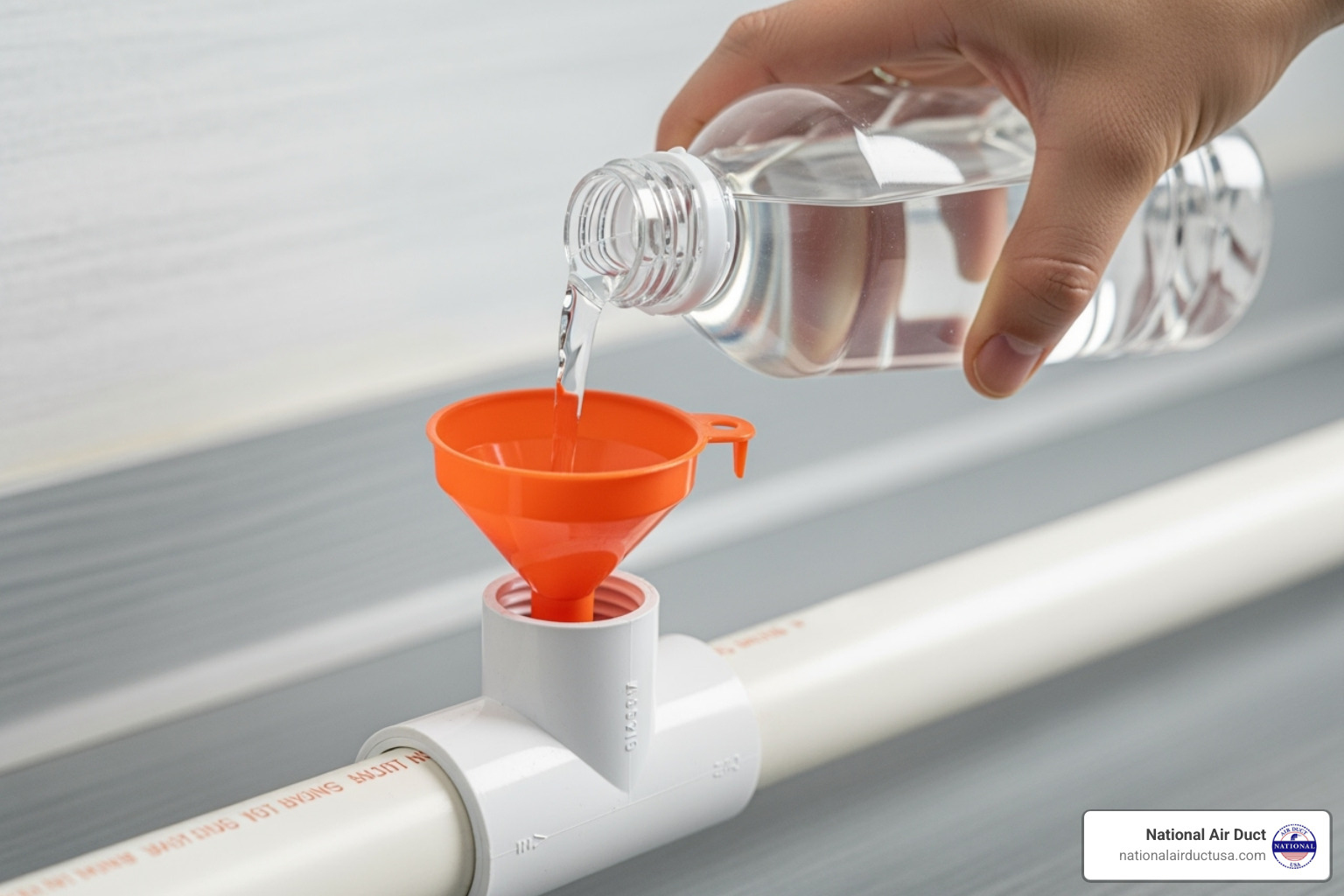
Once the line is clear, replace the PVC cap, restore power at the breaker and thermostat, and turn on your AC.
Proactive Maintenance: How to Keep Your Drain Line Clear
An ounce of prevention is worth a pound of cure, especially with your AC drain line. Regular maintenance can save you from future clogs, water damage, and unexpected AC shutdowns. Here’s how often you should clean air conditioner drain line and what steps you can take to keep it clear.
How Often Should You Clean an Air Conditioner Drain Line?
The ideal frequency depends on your climate and home. If you live in a humid area like New York or have pets, clean the drain line monthly, as high humidity and pet dander accelerate buildup. For most homes in less humid climates, a quarterly cleaning is sufficient.
Even with regular DIY cleaning, we recommend an annual professional check of your entire HVAC system. A technician can perform a deep Coil Cleaning and spot issues you might miss. A consistent schedule is the easiest way to prevent a stubborn clog from forming.
Preventative Products and Best Practices
Beyond regular flushing, these products and habits can help keep your drain line clear:
- Condensate pan tablets: These tablets dissolve slowly in the drain pan, releasing ingredients that prevent the growth of algae, mold, and slime.
- Install a condensate trap: Like the P-trap under your sink, a condensate trap prevents air and sewer gases from being pulled into your home through the drain line. A professional can easily install one.
- Regularly change air filters: A dirty filter allows dust and debris to enter your system, which eventually washes into the drain line and contributes to clogs. Change your filter every 1-3 months.
- Use a high-quality air filter (MERV 5 or higher): A higher MERV rating means the filter is more effective at capturing small particles, keeping them out of your coil and drain line. You can learn more about MERV ratings from the EPA.
- Keep the outdoor unit clear of debris: Ensure the area around your outdoor condenser is free of leaves and grass clippings to help the entire system run more efficiently.
When to Call a Professional for Help
Sometimes a DIY approach isn’t enough, and calling a professional is the smartest move. While it’s rewarding to clean your air conditioner drain line yourself, know when to ask for help.
Trust your instincts. If you’re not comfortable working around electrical components or in cramped spaces, it’s wise to call a technician. A pro is also necessary for stubborn clogs that a wet/dry vac can’t clear. They have specialized tools like a high-pressure Gallo Gun that can blast through tough blockages.
Other reasons to call for help include inaccessible drain lines or any electrical warning signs like burning smells or buzzing sounds. If you see these, turn off the power immediately and call for service. A persistent clog can also be a symptom of a larger issue, like a dirty evaporator coil or a failing condensate pump, which a professional can diagnose.
A professional Air Duct Inspection offers a comprehensive look at your entire HVAC system, identifying ductwork leaks, hidden mold, and efficiency problems. A service call, typically costing between $75 and $200, is a small investment compared to the thousands of dollars in water damage a severe clog can cause. At National Air Duct USA, we provide complete solutions to improve your air quality and prevent costly problems before they start.
Frequently Asked Questions about AC Drain Line Cleaning
Here are answers to some of the most common questions we hear about AC drain line maintenance.
Can a clogged drain line damage my AC unit?
Yes, a clogged drain line can cause significant damage. When water can’t drain, it backs up into the drain pan. If the pan overflows, it can cause serious water damage to your home’s ceilings, walls, and floors. Most modern AC units have a float switch that shuts the system off to prevent this, but this leaves you without cooling.
Furthermore, the stagnant water can cause corrosion of metal parts and lead to electrical shorts if it reaches sensitive components. This can damage or even ruin your AC unit, reducing its overall lifespan. The standing water also promotes mold growth and increases indoor humidity, which harms your home’s air quality. Keeping a clean air conditioner drain line is essential for protecting both your AC system and your home.
Is it better to use bleach or vinegar to clean an AC drain line?
Both are effective, but we generally recommend vinegar as the preferred DIY solution. Distilled white vinegar is a natural disinfectant that is tough on mold and algae but is non-corrosive and safer for your PVC pipes and AC components. A diluted bleach solution (1 part bleach to 6 parts water) is a stronger disinfectant but can be corrosive over time if used improperly.
The most important rule is to NEVER mix bleach and vinegar. This combination creates dangerous chlorine gas. For routine maintenance, vinegar is the safer and equally effective choice to keep your clean air conditioner drain line clear.
What is a condensate drain line cleanout?
A condensate drain line cleanout is an access point designed to make cleaning the line easy. It typically looks like a T-shaped PVC pipe with a removable cap on top and is located on the drain line near your indoor air handler.
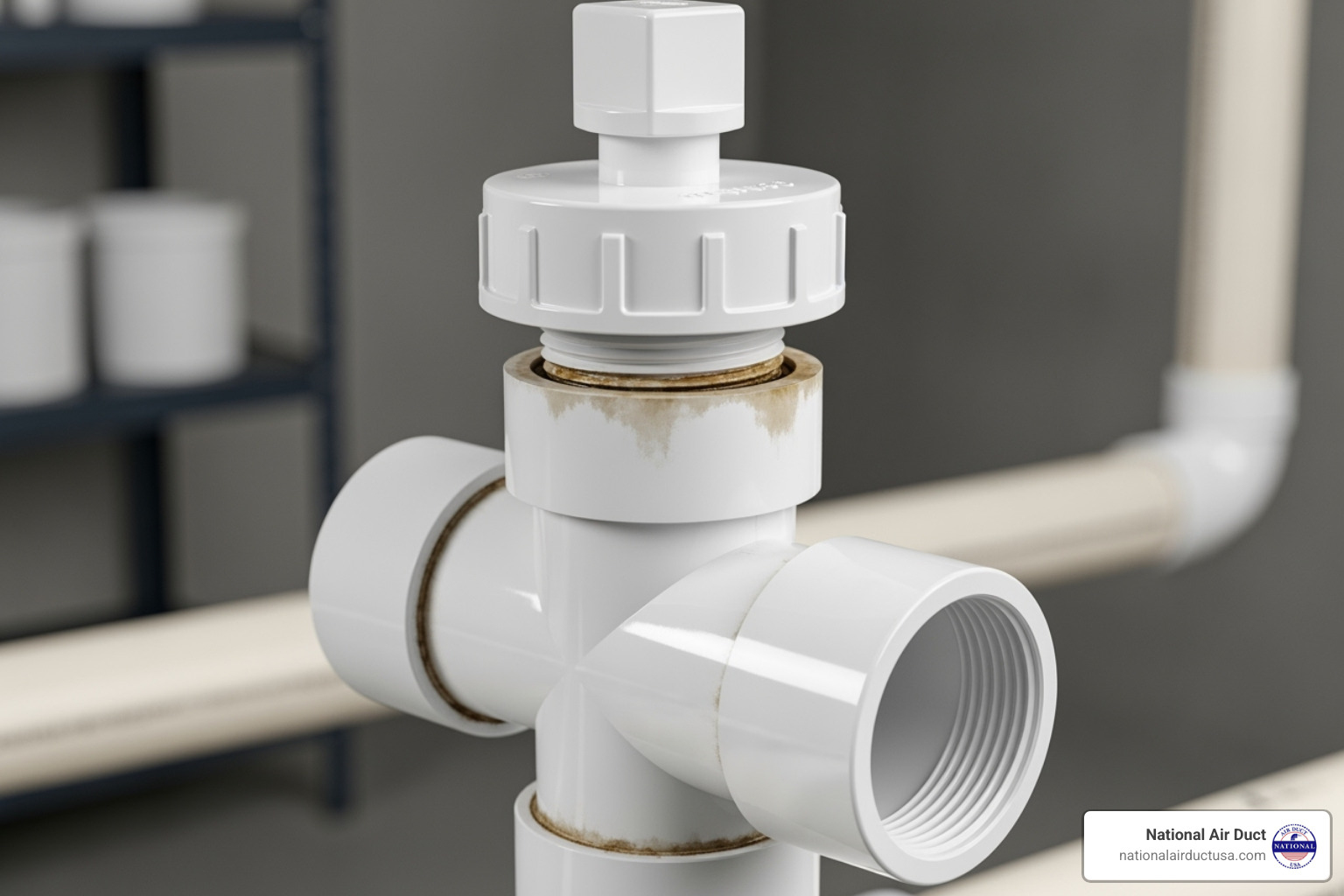
Its purpose is to provide direct access for inspecting the line and pouring in cleaning solutions like vinegar or water. It greatly simplifies the process of maintaining a clean air conditioner drain line. If your system doesn’t have one, an HVAC professional can easily install one during a service visit.
Conclusion: Keep Your System Running Smoothly
Maintaining a clean air conditioner drain line is a critical step in ensuring your home stays cool, comfortable, and healthy. By recognizing the signs of a clog—like standing water in the drain pan, musty smells, or unexpected shutdowns—you can take action before serious problems arise. Consistency is key. Regular cleaning, whether monthly in humid climates or quarterly for most homes, is your best defense against costly clogs.
While many issues can be resolved with a simple DIY cleaning, it’s important to know when to call for help. For a stubborn clog, an inaccessible drain line, or any signs of electrical issues, a professional HVAC technician is your safest and most effective solution. They have the tools and expertise to resolve complex problems safely.
At National Air Duct USA, we are passionate about helping homeowners in Westbury, NY, and throughout New York live more comfortably. Our NADCA-certified experts offer professional and affordable solutions for your entire HVAC system. A clean air conditioner drain line is a cornerstone of a healthy home. For an even deeper clean of your entire system, we invite you to explore our specialized Disinfect HVAC System services. Keeping your system running smoothly provides peace of mind, season after season.

